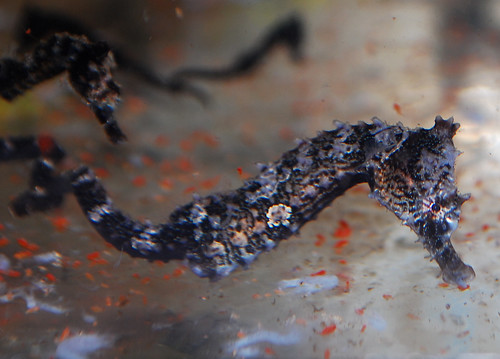 |
| seahorse fry who eat food off the floor are more likely to die before reaching the juvenile stage |
"A hypothesis is discussed that the adaptive immune system of vertebrates evolved in the gastrointestinal regions of primitive jawed fish (placoderms) due to increased localized injuries and infections which were inadvertently brought about by the novel jaw structures and the predatory life style...Initial study of the seahorse (Hippocampus) indicates that the gut-associated immune tissues may be absent in this teleost species, suggesting an evolutionary link between the adaptive immune system and the jaw structure or eating habit."
-summary of Jaw Hypothesis and the Seahorse by Matsunaga T., Rahman A.
In the wild seahorses do not eat dead, decaying food; they only eat live food. Seahorses obviously have some sort of immune system but do not have the gut-associated immune tissue that protects from bacteria that naturally settle on decaying matter (frozen mysis shrimp). Both benign and infectious bacteria (such as Vibrio spp.) are always present in even the cleanest aquariums and in nature. Once a piece of frozen mysis shrimp comes into contact with the bottom of the aquarium, bacteria begin to colonize and break it down almost immediately. When a seahorse eats a piece of frozen mysis shrimp that has been sitting on the floor of the tank too long, it may not get sick right away. The bacteria passes through its gut and is present in the feces which may then contaminate the next meal. Any seahorse that eats the resulting feces-contaminated food is at high risk for bacterial infection. This is why it is important to siphon before and after each feeding.
Keep your seahorse tank clean, and keep the temperature below 74°F
It is much easier to keep a bare bottom seahorse tank clean than a reef-style seahorse tank. A pair of seahorses in a very large tank are less likely to come into contact with their feces, and the clean-up crew usually takes care of any uneaten food. The more seahorses in an aquarium, the more important it is to keep it clean. Scrub the floor and walls of the aquarium daily to prevent buildup of organic material settling there. Siphon feces before each feeding, and siphon uneaten frozen foods immediately after feeding. Clean filters and all tubing at least once a month. keep concentrations of nitrates, phosphates, and organics as close to 0 ppm as possible, as these favor the growth of infectious bacteria and cause stress on the seahorse immune system. Using a UV sterilizer, Protein Skimmer, and strong filter can also help keep the water clean. Have enough current and water flow in all areas of the tank so that "dead zones" of little or now flow are not allowed collect organics and grow bacteria.
You can do a lot to prevent bacterial infections in your seahorse aquarium by keeping temperatures lower than 74°F. Vibrio spp. bacteria become more virulent and aggressive at higher temperatures, while significantly slowing growth at temperatures below 68°F. Vibrio bacterial infections are now one of the leading causes of captive seahorse deaths. If Vibrio can be spread through frozen food that sits on the aquarium floor too long, this may be why seahorses who are fed a diet of live foods are more likely to survive in aquariums with higher temperatures than seahorses who are fed frozen foods.
Further reading:
http://www.angelfire.com/ab/rayjay/temperature.html
Keeping multiple species thread on Seahorse.org (sign in to view topic)

This comment has been removed by a blog administrator.
ReplyDelete